
 |
|
#1
|
|||||
|
|||||
|
Optic choice for AI SOL LED lighting
Related pages
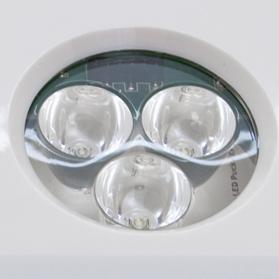 WHAT ARE MY CHOICE OF LIGHTS? On our website there are two versions of the SOL light advertised. SOL BLUE 40/70 - standard light for most tanks 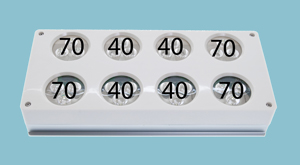 SOL BLUE 40/70 The SOL BLUE 40/70 is the standard format of second generation SOL light and in America, where they are manufactured, this is the only version of the light available for sale The lights have a combination of 70 and 40 degree optics arranged as shown to the left. 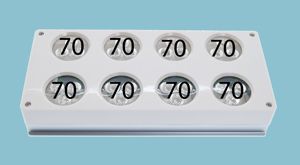 SOL BLUE 70/70 The SOL BLUE 70/70 is a special light for shallower tanks or in combination with other SOL lights above areas where corals are growing very close or at the surface. WHAT IS THE REAL DIFFERENCE BEWEEN THE TWO DIFFERENT OPTICS? 40 degree optics focus the intensity of the light from the LED emitter through a narrower path and therefore the PAR intensity where it reaches the corals, or any surface, will be higher than from the 70 degree optics which produce a more spread and therefore less intense light. 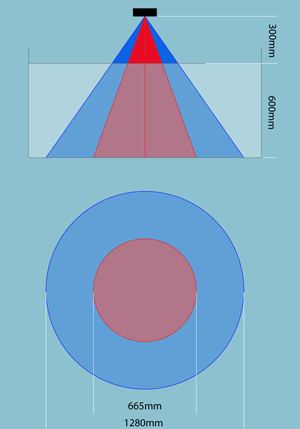 If you draw this out in a simple 2 dimensional representation then you will see that the path that light travels from a 40 degree optic, (RED), differs greatly from that from a 70 degree optic, (BLUE), and in fact the light from the 70 degree path is spread over 1.9X the distance of that from the 40 degree optic. If this is then converted into 3 dimensions, as on the lower diagram, you can calculate that the total AREA that the 70 degree optic covers is actually 3.7X that of the 40 degree. If we now look at this simplified view in terms of intensity or PAR then if, for example, the 40 degree optic produced 500 PAR per cm2 at a particular depth of water then at the same depth with a 70 degree lens from the same LED source you would only achieve 150 PAR per cm2. This is quite a drop however we have not lost this PAR, simply spread it over a larger area and we must therefore rely on overlapping other 70 degree optics to bring the level back to the same intensity as that of the 40. Some people may be looking to opt for the 70/70 lights in the belief that they will require fewer lights to cover the same sized tank however we can see from the above explanation that this is not the case unless it is a fish only system or contains corals with lower light requirements. Multiple 70 degree lights simply produce a more even light as long as the tank is not too deep. SOL 70/70 are also supplied with spare 40 degree lenses allowing them to be converted into a 40/70 light at some stage if required, however they are also slightly more expensive to reflect the additional lenses. It is interesting to see the difference between these two optics and to imagine a comparison with a LED light where there are simple optics or no optics at all and so the spread angle could be anything up to 180 degrees, resulting in a massive waste of the available PAR intensity from the same source LED. THE THIRD OPTION For people with shallower tanks or with surface growing corals the issue with a 40/70 light is not necessarily that it has intense 40 degree optics but more the fact that it has all 4 of the 40 optics together in the middle which can multiply the intensity directly below the centre of the light. The third option is therefore to purchase the standard 40/70 light and then alternate the 40 and 70 degree lenses over the whole area of the light, thus producing a more even spread without losing the intensity and punch of the 40 degree lenses. 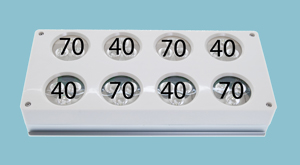 This option perhaps gives the best of both worlds and is a simple matter of removing 4 screws and repositioning the optics. If you are not comfortable to do this then I am sure that your premium dealer will be able to assist you with this. Most people would not need to modify the light in this way and would be happy with the standard 40/70, achieving a greater spread by changing the height of the lights to moderate the intensity. PHOTOGRAPHIC ILLUSTRATION OF THE DIFFERENT OPTIONS We are now getting a better idea of how changing the lenses can alter the intensity of the light and to illustrate this we got Tony, our resident photographic expert, to set up a visual illustration. He set up a jig to hold a sol light 34 inches away from a white ceiling and then set his camera to manual mode and under exposed the image so that it was not all blown out and you could see the subtle differences. This is what he got for different formats of optic position. Note that each light has a much wider spread than is shown however as it is underexposed we are only protographing the very brightest parts in the centre to compare the spread and areas of spot intensity. 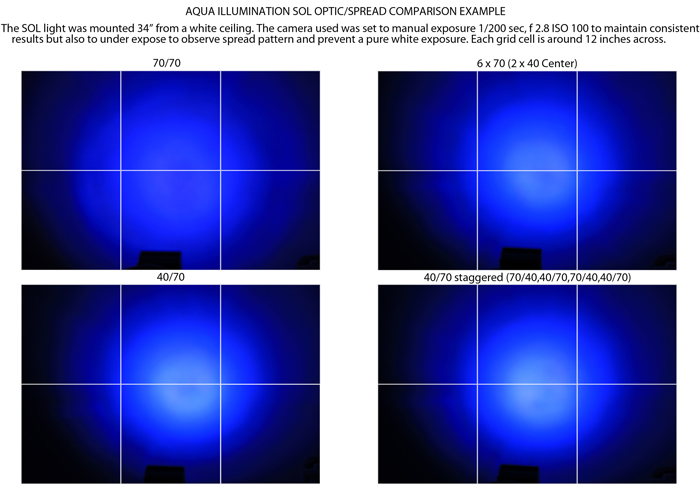 HEIGHT OF LIGHT ABOVE TANK The next thing that will affect the spread and intensity of your LED light, or any light for that matter, is the height that you position it above the tank. Light obeys an inverse square law. This means that if you double the distance from the source then you get 1/4 of the light intensity, (the inverse square), 3 times the distance and you get 1/9th and so on. This can be illustrated by the following diagram. 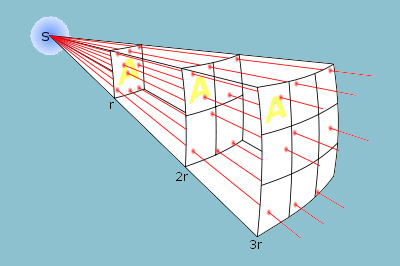 Going back to the first diagram above: Calculation shows that by reducing the height of the light above the water from 12 inches to 6 inches you reduce the spread at the bottom of the tank by 5 inches on the 40 degree lens and by 8 inches on the 70 degree lens. At the same time however you would increase the PAR intensity on a coral just below the surface by 4 times and may run the risk of burning it unless you turn down the power on the controller until it becomes aclimatised. There is a lot to consider for both positioning of corals and choice of lens/mounting height for existing corals and there is no single answer other than to understand the variables at play. WHICH ONE WOULD I CHOOSE A good question and one which I am just about to answer as I am converting my aquarium onto the SOL lights. Initially i was going to go for 70/70 lights however now I have decided to tailor the optics to suit where the corals are in my tank. I will be starting with 40/70 lights and will generally reposition the optics in an alternating format as described on option 3. In specific areas where the lights shine to the bottom of the tank I will be fitting the 40 degree lenses and will save the 70 lenses for areas where the corals are very close to the surface. Fingers crossed this will give me the ideal solution Stuart
__________________
Though a tree grow ever so high, the falling leaves return to the root. 300DD - 140DD  TOTM Fall 2013 |
|
#2
|
||||
|
||||
|
good read.
Greatly appreciated.
__________________
150DD mix reef with 90 gal sump and 40gal frag tank purple tang, sohal tang, yellow eye kole tang, fairy wrasse. cleaner wrasse, leopard wrasse, and misc fish. GHL Mitras 6200HV X 2, MP40 X 2, MP60 X 1, tunze 6095 X 2, Vertex RX6 calcium reactor, Bubble King SM250, Aquamaxx bio pellets reactor, Profilux 3 |
|
#3
|
|||||
|
|||||
|
Interesting..
__________________
Brad |
|
#4
|
||||
|
||||
|
I'm also switching to SOLs this month, I'm getting the stock 40/70 setup, although I think I'm going to design my aquascape around that generally so I have a large spread of potential landscape for different livestock. Even the difference in spectrum will change how the light reaches different depths and angles, so that has to be factored in.
Thanks for the good info, I'm happy to see more math/science information on products instead of marketing fluff. It avoids stupid generalizations like watts/gallon, etc. Having the knowledge of your equipment and livestock is key to being able to make it all work for what you want to keep. |
|
#5
|
|||||
|
|||||
|
Good read. Your tank will be even cooler with Sols!
|